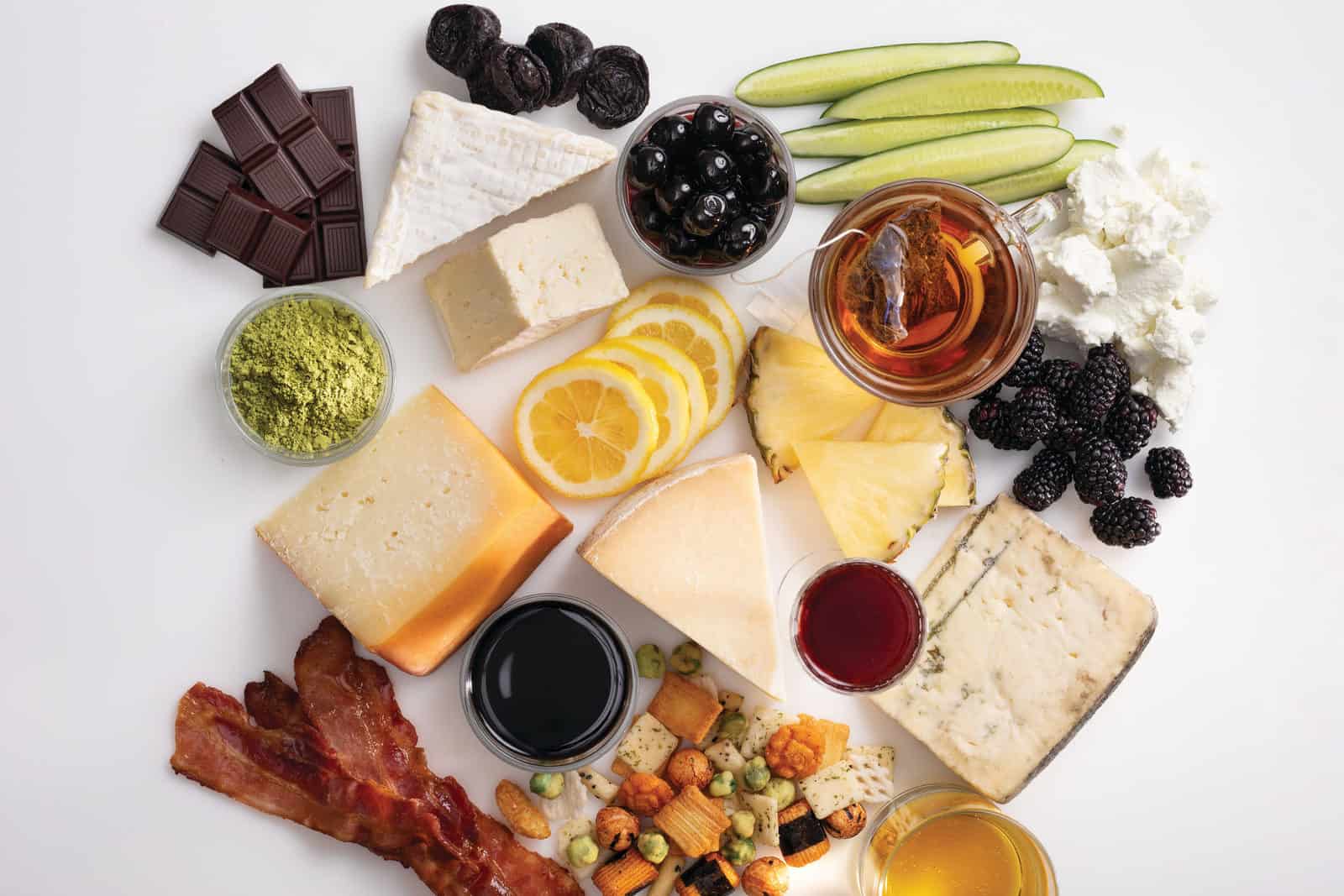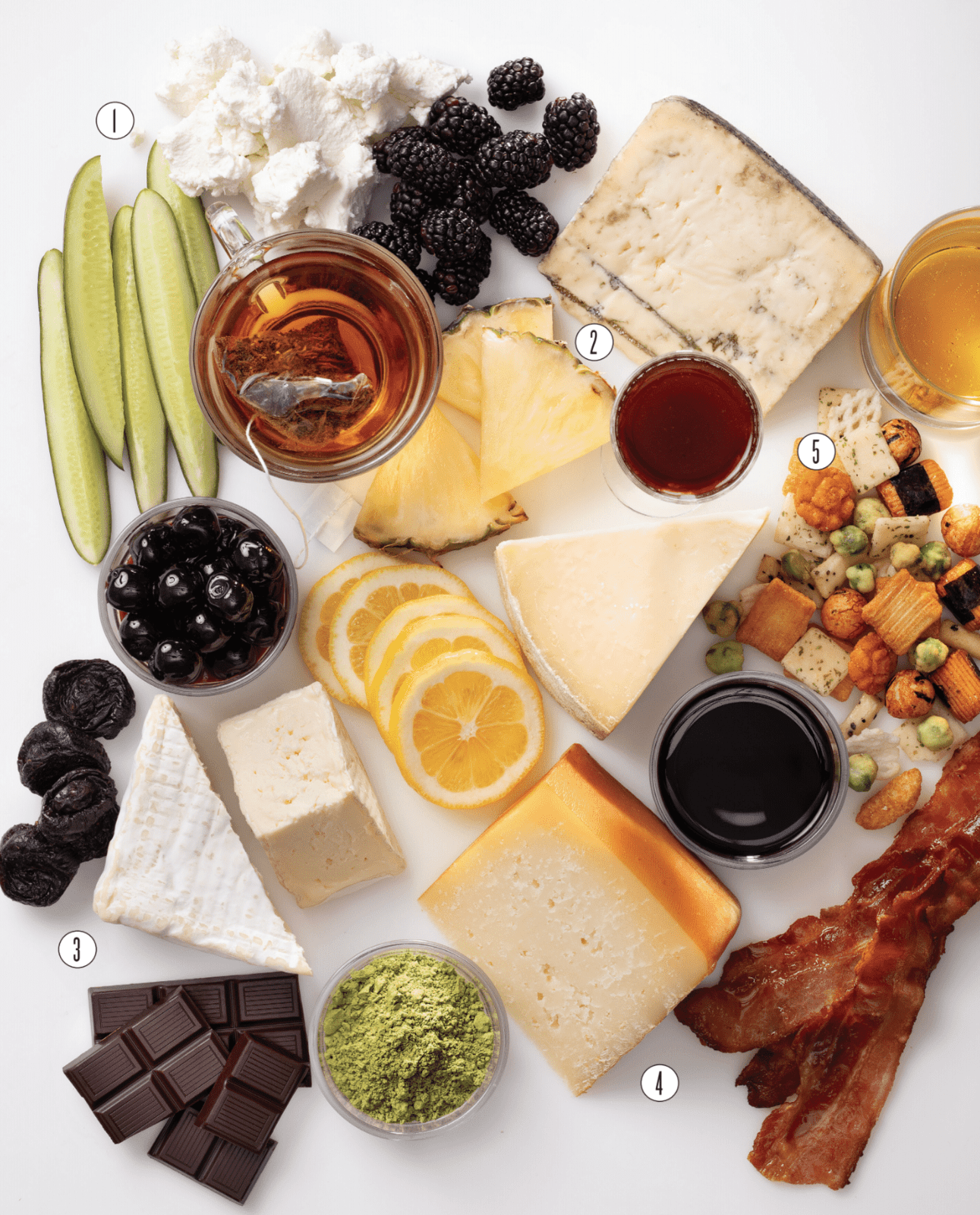
Who makes these rules, and do we need them?
Photographed by Adam DeTour; Styled by Kendra Smith
We make a lot of fuss over pairings in this industry. Restaurants offer wine suggestions, cheese shops overflow with accoutrements—hell, this magazine devotes an entire issue to the subject! Why do we fixate on these match-ups? And how do we decide what works and what doesn’t?
Many classic pairings come to us from other cultures, whose word we take because they’ve been doing it that way for centuries out of socioeconomic or environmental necessity—they ate what grew there, what they could afford or access. (Think: Alpine cheese and potatoes.) We live in a very different world now, with an unfathomable array of options fair game for anyone feeling peckish. In this panoply, pairing dogma helps us solve the omnivore’s dilemma—that is, deciding what to eat. But given the subjectivity of how we experience taste, it may only be able to take us so far.
Humans have between 5,000–10,000 taste buds on their tongues, and this is where the perception of flavor begins. Those buds pick up on the five basic tastes (bitter, sweet, salty, sour, and umami), while our noses take care of the rest. Up to 90 percent of our experience of flavor comes to us through aromas, and our olfactory perception is directly connected to our brain’s memory centers. As a result, we start forming food memories (and preferences) in the womb.
“Flavor preference is complex and influenced by many factors,” says Boston University lecturer and food scientist Valerie Ryan. “Early exposure to certain foods, even in utero, and family culinary practices play a large role, as do cultural norms. What’s considered delicious in some parts of the world is disgusting in others.”
And yet we see some of the same pairings replicated in cultures and climates all over—Central America’s guava paste and farmer’s cheese shares a creamy-tangy framework with Taleggio and mostarda in Italy, or even the orange creamsicle here in the U.S. Certain flavors find their way to each other, no matter the local weather patterns, and our nutritional needs may be the reason. Our bodies crave acidity to counter something rich and milky; likewise, too much sugar causes us to crave its opposite, resulting in the now-ubiquitous salty chocolate bar.
We orient ourselves toward balance when combining disparate foods—but pairing science isn’t all about stark antipodes. In fact, for a group of chefs and scientists in Belgium, harmonious plating starts with similitude.
Peter Coucquyt, Bernard Lahousse, and Johan Langenbick launched their food tech company Foodpairing in 2007 on a simple theory: Complementary ingredients share aromatic compounds. They’d tested this hypothesis by analyzing ingredients using gas chromatography-mass spectrometry, and it held up to scrutiny. To date, they’ve analyzed over 3,000 ingredients, amassing the world’s largest flavor database. In their book, The Art and Science of Foodpairing, they break ingredients down into 14 aroma types (“spicy,” “animal,” “green,” to name a few) and create flavor wheels to visualize how much each type shows up in each ingredient. They then pair ingredients with similar aromatic qualities in grids that outline what they have in common. But even when two ingredients suit one another, there are certain ineffable properties necessary to make things gel.
“An aromatic pairing is only one part of a successful recipe,” says Coucquyt. According to the book, good pairings walk a thin line between complexity and coherence—too much complexity is overwhelming, while too little is boring. In this way, your own memory becomes a key ingredient in a successful pairing. To explain this, the book uses the example of Mexican mole—the incongruous grouping of chili, chicken, peanuts, and chocolate may register as too complex to someone without a history of eating the dish.
“The reasons some flavors pair well for one individual and not another go beyond what we can determine objectively in a lab,” says Ryan. Our own pasts can render certain pairing suggestions moot, making it difficult to rely on any hard and fast rules. And sometimes, the rules overshadow what we’re really all here for: the cheese.
“I’m not a big pairing person.” This is Dave Selden, creator of 33 Books Co. He publishes tasting journals for things like cheese, beer, and whiskey, each including a flavor wheel of taste words similar to Foodpairing’s grids. But Selden set out to help consumers find what they like, not to facilitate pairing. “I’m not a person that says, OK, let’s try this dark chocolate with this goat cheese. I will eat them and enjoy them, but kind of separately,” he says. “A lot of effort went into making it taste a certain way, and I don’t know that I’m qualified or really interested in changing it all that much.”
Too much pairing talk can also alienate the consumer. “People are often intimidated by cheese,” says Erin Carlman Weber, co-owner of Chicago restaurant and cheese counter All Together Now. “Sometimes the focus on exact proper pairings can add to that fear.” For Carlman Weber, it’s best to focus on the real-world contexts in which people eat. “There’s a great beverage pairing for every cheese, but if you’re standing around a cheese board at a party, you probably have a glass in your hand,” she says. “When I’m talking to people about what kind of things to have handy, I’m thinking about versatility, and not overshadowing the cheese.”
I heard this unfussy culture reset everywhere I looked—even from those who make their name crafting Instagram-perfect boards. “Taste is definitely the most important factor of a cheese plate,” says Marissa Mullen, author of That Cheese Plate Will Change Your Life. She developed a six-step Cheese By Numbers method to help people build coherent cheese plates, but says at the end of the day, you should eat what you like. I asked Mullen what she thought of cheese plate stunt casting, like the ever-present (and messy) pomegranate wedge. “I feel there’s a difference between the ‘photo-ready’ plate and the plate for serving,” she says. When Mullen includes pomegranate, she’ll set it aside after pictures for guests to tackle at their own risk.
All told, there are more questions than answers when it comes to food pairing, and it may not be possible to untangle this Gordian knot in one article. We seem to have outgrown the overly precious approach to culinary matchmaking, but we can’t abandon the practice altogether. Some foods need each other—take rice and beans, a complete protein only when eaten together. Experimentation is evolutionarily necessary—we may always be asking, “Can I eat x with y?” Sure, we could survive on Soylent and vitamins, but to do so would abandon the emotional component of flavor. The part of us that remains loyal to the food we grew up with is, simultaneously, the part stubbornly dedicated to the human tradition of new things.
—The Scientist’s Cheese Plate—
Using The Art and Science of Foodpairing’s flavor wheels, we traced the aroma compounds present in a few of our favorite cheeses to like-minded ingredients. Let these harmonious clusters form the backbone of your next cheese plate!

1. CHÈVRE, CUCUMBER, BLACK TEA, BLACKBERRY
TRY: Laura Chenel Original French Goat Cheese
Sharing many green vegetal aromas, these bright items are grounded by the tea’s bitterness and the chèvre’s animal and coconut scents.
2. BLUE CHEESE, PORT, PINEAPPLE
TRY: Caveman Blue, Quinta do Infantado Ruby Port
These ingredients share an ester called ethyl hexanoate, which has a tropical fruit flavor and can register as faintly cheesy in low concentrations.
3. BRIE, PRUNES, YUZU, MARASCHINO LIQUEUR, DARK CHOCOLATE
TRY: Haystack Mountain Cashmere, Tulip Tree Creamery Trillium, Fruition Colombia Tumaco Dark 85% chocolate
How can you bring this bouquet of malty, woody, and floral notes together? Shake up a yuzu Aviation to sip alongside a dessert plate of Brie and chocolate.
4. IDIAZABAL, BACON, SOYSAUCE, MATCHA
The fruity, cheesy, and nutty aromas these ingredients share set off complementary waves of umami, each one different from the last.
5. FARMHOUSE CHEDDAR, SEAWEED PARTY MIX, GINGER BEER
TRY: Murray’s Stockinghall Cheddar, Hapi Mixed Crackers
The distinct elements of this ready-to-go snack plate are unified by a common devotion to tingly spice and grassy green flavors.
DIY SNACKS
If you make a lot of cheese plates, the pairings can get kind of stale—no offense to fig jam and honey. Give your board are fresh with something from your own kitchen.
Dry your own fruit: A perfect pandemic activity for the sourdough-challenged, and doable in your oven at a low temp.
Candy/crystallize something: A great opportunity to work in a complementary flavor, you can mix anything powdered into the sugar you use to encrust fruit or citrus rind—chili mango is a classic.
Infusions: Want to wake up your honey? Plunk a cluster of lilac blossoms (or a dried chili, or coffee beans) into the jar. This works for maple syrup, too!
Think outside the booze: Wine and beer are great with cheese, but so are drinking vinegars, homemade bitters dashed into seltzer, grassy green juices, and fruit sodas.
Reach into your cabinets—and your grandma’s cabinets: We can’t overstate the power of positive associations. Have a favorite granola? Crumble it on top of a soft cheese. Have a childhood snack you’ve never seen near cheese? Don’t be so sure it won’t work. If you like two ingredients, pop ‘em in your mouth at the same time and see what happens.
Still hungry? Get more pairing guidance here.




